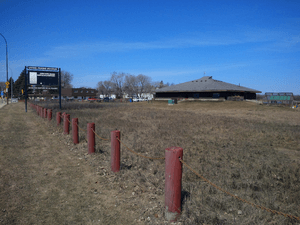Living Prairie Museum facts for kids
Quick facts for kids Living Prairie Museum |
|
|---|---|
| Le Musée-Nature de la Prairie | |
 |
|
| Type | Tall grass prairie reserve |
| Location | 2795 Ness Avenue Assiniboia, Winnipeg, Manitoba, R3J 3S4 Canada |
| Area | 30 acres (12 hectares) |
| Elevation | 777.6 feet (237.0 m) |
| Created | 1968 |
| Open | May–June (Sun. 10–5) July–Aug. (Daily 10–5) Sep. (Sun. 10–5) |
| Species | 160 |
| Public transit access | 24 Ness Express 25 Ness Super Express 83 - Unicity - Strauss Drive - Murray Industrial Park |
The Living Prairie Museum is a special place in Winnipeg, Manitoba, Canada. It's a 30-acre (12 ha) nature preserve that protects a rare type of grassland called a tall grass prairie. You can find it in the St. James-Assiniboia area of Winnipeg.
This museum is more than just a building; it's a living outdoor space. It helps people learn about the history and importance of tall grass prairies. These prairies were once huge, covering vast areas of North America.
Scientists discovered this amazing spot in 1968. They were looking for original prairie lands in Manitoba. Out of over 60 places they checked, only four were still untouched by farming or city growth. The Living Prairie Museum was one of the biggest and best examples found right inside Winnipeg!
Today, the Living Prairie Museum is a protected City of Winnipeg Nature Park. It's home to over 160 different kinds of prairie grasses and wildflowers. Many types of prairie wildlife also live there. It's a small but very important piece of what Manitoba's landscape used to look like.
The museum also has an indoor centre. Here, you can see displays about prairie history and how this ecosystem works. There's even a cool art display called lost_landscape by Winnipeg artist Collin Zipp.
Contents
How the Living Prairie Museum Started
The Living Prairie Museum was created to save a piece of untouched land. In 1970, the City of St. James-Assiniboia decided to protect 26.5 acres (10.7 ha) of this special prairie. This land had never been farmed or built on.
Leaders at the time knew how important this prairie was. They said it was a rare example of original plant life. Over 125 different plant species had already been found there. Many of these plants were becoming rare in Manitoba.
They understood that natural areas were disappearing quickly due to farming and city growth. The museum's location within the city made it unique. It offered a chance for everyone, young and old, to experience a natural part of their heritage.
Building the Interpretive Centre
In 1973, the Winnipeg Council approved plans for an interpretive centre. This building would help visitors learn even more about the prairie. The city agreed to pay $50,000 towards the project.
A special ceremony took place in April 1974. The Governor General, Jules Leger, attended to mark the start of construction. The Interpretive Centre officially opened its doors to the public on June 23, 1976.
After the museum opened, some local residents wanted to protect even more land. They asked for an additional 50–100 acres (20–40 ha) to be added to the museum. This extra land was zoned for industrial use at the time.
Protecting the Prairie from Roads
In the 1960s, there were plans to build a major highway, called the Western Freeway. This road was supposed to cut right through the Living Prairie Museum. Local residents spoke up and suggested building the road further north instead. Luckily, the freeway project was eventually cancelled, saving the prairie.
Who the Museum Works With
The Living Prairie Museum works with several important organizations. These partnerships help the museum share its knowledge and protect the prairie.
- CMA: This group supports museums across Canada.
- CHIN: This network helps museums manage and share their collections digitally.
- Virtual Museum of Canada: This online platform allows people to explore Canadian heritage from anywhere.
See also
 In Spanish: Museo Living Prairie para niños
In Spanish: Museo Living Prairie para niños

